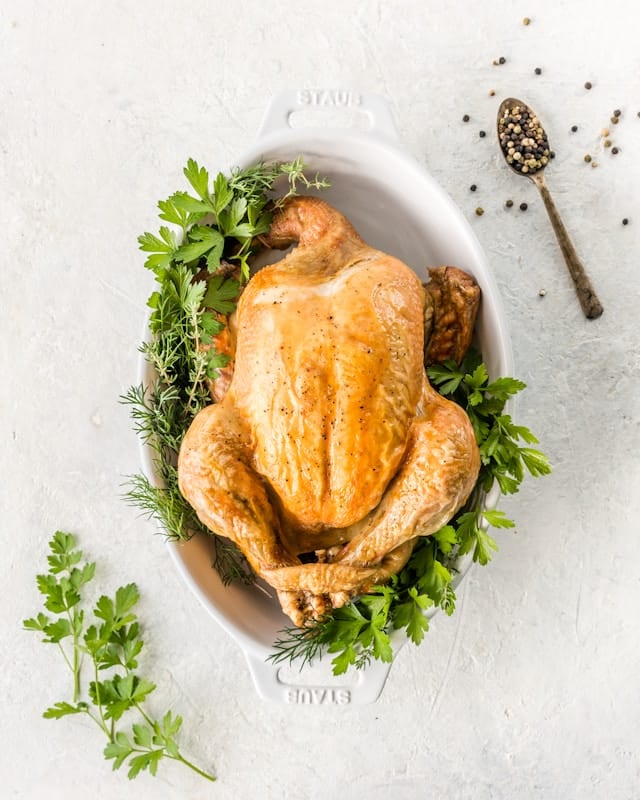What’s the Secret to a Perfectly Spiced Gourmet Moroccan Chicken Tagine?

The enigmatic allure of Moroccan cuisine often sparks culinary curiosity and an insatiable desire to recreate these exotic dishes. Amongst the vast range of Moroccan dishes, none is more representative of this country’s culinary landscape than the Chicken Tagine. Named after the traditional earthenware pot it is cooked in, the tagine is a slow-cooked stew that is both wholesome and bursting with an intricate blend of flavors and textures. The secret to perfecting this gourmet dish lies in the masterful balance of its key components: chicken, lemons, olives, and a meticulously crafted sauce.
Carefully Selecting and Preparing Your Chicken
The first secret to a perfectly spiced gourmet Moroccan Chicken Tagine lies in the careful selection and preparation of the chicken. Quality, fresh chicken is a must. The preference is for a whole chicken, cut into pieces, leaving the skin on. The skin adds flavour and prevents the chicken from drying out during the long cooking process.
Cela peut vous intéresser : How Can You Craft a Gourmet Walnut and Blue Cheese Salad with a Maple Balsamic Vinaigrette?
Cleaning the chicken properly is essential. Rinse thoroughly under cold running water, and pat dry with kitchen towels. Once clean, season the chicken with Moroccan spices like turmeric, cumin, paprika, and saffron. This initial step of infusing the chicken with spices sets the foundation for the dish’s robust flavor profile.
The Art of Cooking the Chicken
It’s not just about adding the chicken to the tagine and waiting. The process is an art. Begin by heating a generous amount of olive oil in your tagine pot over medium heat. Add your seasoned chicken pieces, ensuring they get an even colour on all sides.
A lire également : What’s the Best Way to Prepare a Luxurious Gourmet Oyster Bisque?
The trick is to allow the chicken to sear, locking in the juices and adding to the overall flavour of the dish. Once seared, reduce the heat and let the chicken cook slowly. This slow cooking process allows the chicken to become tender and flavorful, soaking in the spices and sauces.
Crafting an Authentic Moroccan Sauce
The sauce in a Moroccan chicken tagine is crucial. It’s a delicate balance of flavours, created by combining a medley of aromatic spices, garlic, and onions with a foundation of rich chicken stock. To start, sauté onions and garlic in the same pot after removing the chicken. Add your spices – a blend of cumin, saffron, ginger, and coriander.
Then, pour in chicken stock, scraping the bottom of the pot to incorporate all the delicious, caramelised bits into your sauce. Allow this to simmer for a few minutes, intensifying in flavour. This sauce will bathe your chicken, lemons, and olives, tying the entire dish together.
The Role of Preserved Lemons and Olives
The distinctive tang of preserved lemons and the salty bite of olives are signature elements of a Moroccan chicken tagine. Preserved lemons, unlike fresh lemons, have a unique, intense citrusy flavor that penetrates the dish, providing a bright counterpoint to the rich, savory sauce.
Similarly, olives – preferably Moroccan or Kalamata – add a depth of flavour with their briny, salty notes. To incorporate, add your preserved lemons and olives into the tagine pot about halfway through the chicken cooking time. This will allow these key ingredients to infuse their distinct flavours into the dish.
Finalizing the Dish
As the dish nears the end of its cooking time, monitor it closely. The sauce should reduce to a thick, rich consistency, coating the chicken and the other ingredients beautifully. The chicken should be tender, and the preserved lemons and olives soft but still intact.
At this point, you can add a handful of fresh chopped cilantro or parsley for a burst of fresh flavor. Cook for an additional few minutes, allowing the herbs to wilt and infuse into the sauce.
Cooking a Moroccan chicken tagine is not just a recipe, but a journey into the heart of Moroccan cuisine. It is a delicate balance of carefully selected ingredients, meticulous preparation, and slow, precise cooking. However, with patience and practice, you can unlock the secrets of this gourmet dish and create a tantalizing Moroccan feast right in your own kitchen.
Perfecting the Use of Preserved Lemons and Olives
In a Moroccan chicken tagine, preserved lemons and olives play a key role, contributing to the distinctive flavor profile of this traditional dish. Preserved lemons provide a powerful citrus punch, which contrasts beautifully with the savory chicken and aromatic spices. Unlike the fresh variety, preserved lemons bring an intensified citrusy flavor that adds brightness to the tagine.
Incorporating preserved lemons into your tagine is straightforward. Slice them thinly, removing any seeds, and add them to the pot around the mid-point of the chicken’s cooking time. This allows their intense, tangy flavor to permeate the dish without overpowering it.
The salty bite of olives lends another layer of complexity to the tagine. Opt for Moroccan or Kalamata olives for their robust flavor and firm texture. When adding olives, preserved in brine, to the taginepot, ensure to do so halfway through the chicken cooking time, giving them a chance to infuse their briny flavor into the dish.
It’s these well-thought-out additions that build the flavorful complexity of a Moroccan chicken tagine, elevating it from a simple chicken stew to a gourmet feast.
Crafting the Perfect Moroccan Chicken Tagine Conclusion
Mastering the art of making a Moroccan chicken tagine is about more than following a recipe. It’s about understanding the harmony between the ingredients and how their flavors and textures interact to create a gourmet dish representative of Moroccan cuisine’s complexity and richness.
Begin with high-quality chicken pieces, seasoned and prepared with care, and slow-cooked to perfect tenderness. Devote time to crafting a flavorful sauce using a blend of spices, garlic, and onions, and a robust chicken broth base. Understand the pivotal role of preserved lemons and olives, and how their distinct flavors contribute to the finished dish.
Remember that the tagine pot is just as important as the ingredients. Whether you’re using a traditional earthenware tagine pot or a modern Dutch oven, the slow, even cooking and the steam’s recirculation will ensure your chicken is tender and flavorful.
In the end, cooking a Moroccan chicken tagine isn’t just about creating a meal—it’s about embarking on a culinary journey that introduces you to the unique flavors and textures of Moroccan cuisine. With patience and practice, you’ll find that the secret to the perfect Moroccan chicken tagine lies in the balance and harmony of its components. As you lift the lid off your tagine pot, releasing the fragrant steam, you’ll know that you’ve not just cooked a dish, but created an experience.
